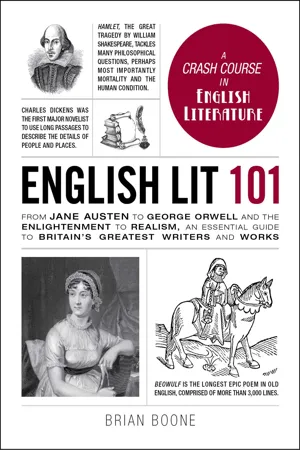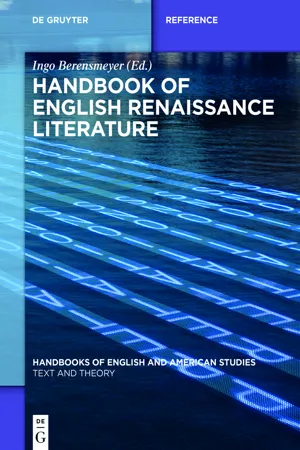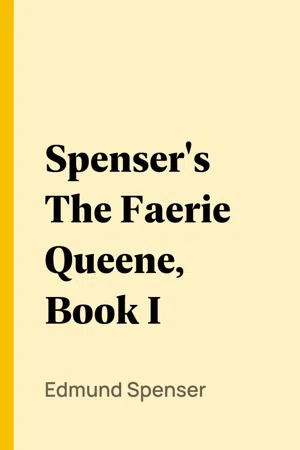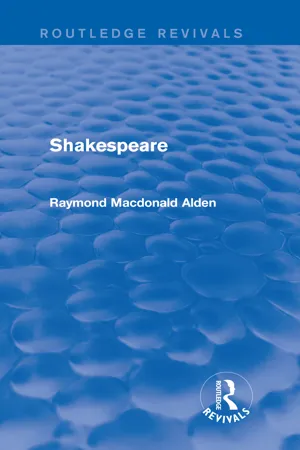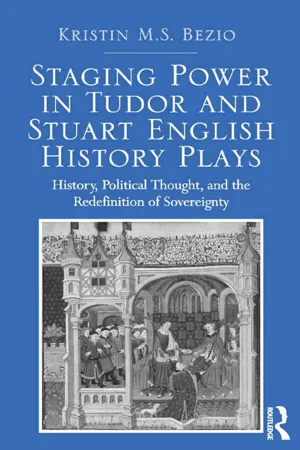History
Elizabethan Era
The Elizabethan Era, named after Queen Elizabeth I of England, spanned from 1558 to 1603. It was a time of great cultural and artistic flourishing, with the works of playwrights like William Shakespeare and Christopher Marlowe gaining prominence. The era also saw significant developments in exploration, trade, and the arts, leaving a lasting impact on English history and culture.
Written by Perlego with AI-assistance
Related key terms
5 Key excerpts on "Elizabethan Era"
- eBook - ePub
English Lit 101
From Jane Austen to George Orwell and the Enlightenment to Realism, an essential guide to Britain's greatest writers and works
- Brian Boone(Author)
- 2017(Publication Date)
- Adams Media(Publisher)
Chapter 2
The Elizabethan Era
Also known as the English Renaissance, the Elizabethan Era was the golden age of English literature. This time period, which ran approximately from 1558 to 1603, was an unparalleled era of growth and quality of the written word, characterized by the development of the novel, new and lasting innovations in poetry, and new styles of theater that would incubate the most important and popular plays in the English language.While Queen Elizabeth I, the monarch of the time, didn’t directly affect the art of the day, the tone of her reign was one of English pride, prosperity, and political dominance. The English were thriving, not merely surviving, and life was comfortable enough that writing was a viable trade, not just a pursuit afforded to those from wealthy families. (Theater was still viewed as a low art for commoners, but William Shakespeare and Ben Jonson would dispel that notion.)The Elizabethan Era was a great leap forward after the experimentation and baby steps of the previous 500 years, in which literature was primarily a tool for politics and religion. Writers now explored a variety of topics, especially any and all aspects of the human condition. But despite that commitment to realism, works were not presented in an entirely realistic way. Poems and theater of this era were especially noted for their flowery, emotional speech and were driven by meter and a rhyme scheme that was well suited to performance.Celebrating the language was a form of national pride—important as England circumnavigated and conquered the globe, spreading “Englishness” throughout. With this exploration and contact with other cultures came new words from foreign languages that writers were eager to add to their toolboxes. By doing so, these writers helped make English a vaster and more expressive language. - eBook - ePub
- Ingo Berensmeyer, Ingo Berensmeyer(Authors)
- 2019(Publication Date)
- De Gruyter(Publisher)
The increase of royal power continues under Henry VIII (1491–1547), whose break with the Roman Church in 1532 makes the English sovereign the supreme head of the Church in England. Following the brief reign of Edward VI, who dies at the age of fifteen in 1553, and the even shorter reign of Jane Grey (the ‘Nine-Day Queen’), Mary I (1516–1558) returns the country to Catholicism. This is reversed five years later by the accession of her half-sister Elizabeth I (1533–1603), the daughter of Henry VIII and Anne Boleyn. Elizabeth continues and consolidates the Reformation as well as the administrative reforms initiated under the early Tudors. A decisive victory over the Spanish fleet, the famous Armada, in 1588 secures England’s status as a naval power, opening up possibilities of international trade and colonial exploration. When Elizabeth dies childless in 1603, there is a brief moment of dynastic insecurity that ends with the accession of James VI and I (1566–1625), King of Scotland and England, the first Stuart king on the English throne.The reign of Elizabeth I has entered popular mythology as a ‘golden age’, and it certainly saw a flourishing of the arts, especially in poetry and drama. But the seeds for this were planted earlier, and its fruits were still being reaped long after her death. There is some political stability during her reign, but this is bought at the price of an oppressive and intrusive interior politics, including a well-managed network of spies and the reintroduction of torture, applied most dramatically to Catholic enemies of the state like the Jesuit Edmund Campion (1540–1581). This coincides with an increasingly harsh stance towards Ireland, which is systematically colonised during her reign and whose rebels are suppressed by military force (an important subtext to the most ambitious literary work of this period, Spenser’s Faerie Queene (1590/96; ↗ 17 Edmund Spenser, The Faerie Queene). This darkening of the Elizabethan age in its later years is epitomized in the Essex rebellion of 1601, a failed coup by Elizabeth’s former favourite, Robert Devereux, the Earl of Essex (1566–1601).The flowering of the arts can also be recognised in Scotland. For this reason, it might be more justified to speak of a British rather than English Renaissance. The political union of Britain is promoted by King James but not realised until 1707 (see Kerrigan 2008 , Shapiro 2015 ). Even though English influence is felt to be growing across the Isles in this period, it is not a unified or systematic presence; the period’s linguistic and cultural plurality should not be underestimated. There is a wide variety of writing in other vernacular languages such as Welsh, Irish and Scottish Gaelic, as well as in the classical languages: Latin is widely taught and used as the language of international diplomacy as well as learning. Well into the seventeenth century, legal texts are composed in a variety of Anglo-Norman French known as Law French. The cultural centres in this period beside London are the universities of Oxford and Cambridge, both medieval foundations. In the Kingdom of Scotland, the university of St Andrews is founded in 1418, followed by Glasgow (1451), Aberdeen (1495), and Edinburgh (1582). Edinburgh is also a cultural hub in the North, with a vibrant court and the first Scottish printing press in 1507. A number of Scottish poets including Robert Henryson (c. 1430–c. 1505), William Dunbar (c. 1456–c. 1515), Gavin Douglas (c. 1475–1522) and David Lindsay (c. 1486–1555) write in an English dialect known as Middle Scots; their works, while influenced by Geoffrey Chaucer (c. 1340–1400), attest to a vibrant literary activity in late medieval and early Renaissance Scotland (see Dunnigan 2013 - eBook - ePub
- Edmund Spenser, George Armstrong Wauchope, (Authors)
- 2005(Publication Date)
- Perlego(Publisher)
Add to this intense delight in life, with all its mystery, beauty, and power, the keen zest for learning which filled the air that men breathed, and it is easy to understand that the time was ripe for a new and brilliant epoch in literature. First among the poetic geniuses of the Elizabethan period came Edmund Spenser with his Faerie Queene, the allegory of an ideal chivalry. This poem is one of the fruits of that intellectual awakening which first fertilized Italian thought in the twelfth century, and, slowly spreading over Europe, made its way into England in the fifteenth century. The mighty impulse of this New Learning culminated during the reign of the Virgin Queen in a profound quickening of the national consciousness, and in arousing an intense curiosity to know and to imitate the rich treasures of the classics and romance. Its first phase was the classical revival. The tyrannous authority of ecclesiasticism had long since been broken; a general reaction from Christian asceticism had set in; and by the side of the ceremonies of the church had been introduced a semi-pagan religion of art—the worship of moral and sensuous beauty. Illiteracy was no longer the style at court. Elizabeth herself set the example in the study of Greek. Books and manuscripts were eagerly sought after, Scholars became conversant with Homer, Plato, Aristotle, and the great tragic poets Sophocles, Euripides, and Æschylus; and translations for the many of Vergil, Ovid, Plautus, Terence, and Seneca poured forth from the printing-presses of London. The English mind was strongly tempered by the idealistic philosophy of Plato and Aristotle, and the influence of Latin tragedy and comedy was strongly felt by the early English drama. Along with this classical culture came a higher appreciation of the beauty of mediævalism - eBook - ePub
- Raymond Alden(Author)
- 2014(Publication Date)
- Routledge(Publisher)
N 1564, when Shakespeare was born, Elizabeth had been on the throne of England for five and a half years, and the reign which more than any other still seems to represent the greatness of modern England was in full course. The Queen had already impressed her personality upon the government, and in a few more years was to make it felt throughout every corner of the land. After years of confused national feeling, and painful internal religious conflict, the beginnings of a stedfast political consciousness and of a fair degree of ecclesiastical unity were calming the hearts of the people, and making possible the great attainments of the early future in the fields of war, exploration, commerce, and the arts. When Shakespeare was six years old Elizabeth was excommunicated by the Pope; when he was eight, the court went into mourning in protest against the massacre of St. Bartholomew’s Day; and by these events the popular strength of British Protestantism was confirmed. When he was thirteen, Francis Drake set out on his voyage to South America and around the world, returning to Plymouth in Shakespeare’s seventeenth year. Seven years later, when the poet was probably a resident of London, Drake commanded the active division of the fleet which, in alliance with wind and ocean, defeated the Spanish Armada, and thereby made England definitively the leader of the Protestant powers. At the height of Shakespeare’s dramatic career, in 1603, the reign of Elizabeth came to an end with her death and the accession of James; but the England which she had so long incarnated before the world is still called “Elizabethan” throughout the reign of her successor. The new régime, despite the many differences that marked the personality of the sovereign, was in most respects a continuation of the old, and the poets and playwrights who had made glorious the court of the Virgin Queen became servants and celebrators of His Majesty, just as the admirals and gentlemen adventurers continued the story of English achievements in the West. During the years when Shakespeare was bringing his active career as dramatist to a close, from 1607 to 1611, the colony in Virginia was being founded and struggling into permanent form; and in 1616, the year of his death, Raleigh was making preparations for his final ill-fated expedition to the Spanish Main. At about the same time the English separatists at Leyden were inaugurating plans for the migration which was to result in the settlement of New England. King James survived the greatest of his subjects by nine years, and saw, two years before his death, the publication of Shakespeare’s collected plays. Twelve years earlier,—that is, five years before the death of Shakespeare,—had appeared the Authorized Version of the Bible. Thus it happened to be granted to James, and not to Elizabeth, that his reign should be made forever memorable by the appearance in close succession of the two books which are the chief glories of the English race.If we now look at the same period from another standpoint, that of European culture rather than British history, we note first of all that it represents the culmination of the indefinable but pervasive moment which we call the Renaissance. Reaching Great Britain comparatively late, the influences covered by the word were only at the point, in early sixteenth-century England, which had long since been passed in Italy and only a little less long in France. The founding of John Colet’s Grammar School in 1510, the first regular Greek lectureship at Oxford in 1520, and the appearance of Coxe’s Rhetorick - eBook - ePub
Staging Power in Tudor and Stuart English History Plays
History, Political Thought, and the Redefinition of Sovereignty
- Kristin M.S. Bezio(Author)
- 2016(Publication Date)
- Routledge(Publisher)
Chapter 2 The Queen and the Stage: The Rise of Popular Theater in Elizabethan England (1558–1580)When Elizabeth Tudor inherited the throne in 1558, she entered London in triumph in an extravagant royal passage, setting the literal and proverbial stage for a 45-year reign in which ceremony, pageant, and theatricality came to define and redefine the English monarchy. In large part, Elizabeth’s reliance upon spectacle arose from her need to counteract the questionable legitimacy and scandal that accompanied her succession. The controversies surrounding Elizabeth’s accession included—but were not limited to—her proclaimed bastardy, her Protestantism, her gender, a suspected affair with (or assault by?) Thomas Seymour, involvement with Wyatt’s Revolt (1554), and the possibility of a betrothal and marriage to her late sister’s Catholic husband, Philip of Spain. Despite these, Elizabeth was determined to be her father’s daughter, a decision that reflects her keen awareness of the importance of pageantry and public spectacle to the foundation and perception of monarchical power. In her response to its 1586 petition to execute Mary Queen of Scots, Elizabeth herself (now famously) informed Parliament thatfor we princes, I tell you, are set on stages in the sight and view of all the world duly observed. The eyes of many behold our actions; a spot is soon spied in our garments; a blemish quickly noted in our doings. It behooveth us therefore to be careful that our proceedings be just and honorable.1Awareness of her position as a performative public figure characterized her entire reign. This understanding is particularly interesting because such an explanation of sovereign visibility presupposes a system of limited participatory governance.As Michael J. Braddick and John Walter discuss in their introduction to Negotiating Power in Early Modern Society
Index pages curate the most relevant extracts from our library of academic textbooks. They’ve been created using an in-house natural language model (NLM), each adding context and meaning to key research topics.
